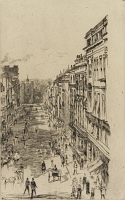Etchings Institutions search term: athenaeum
St James's Street | ||
| Number: | 178 | |
| Date: | 1878 | |
| Medium: | etching and drypoint | |
| Size: | 275 x 155 mm | |
| Signed: | butterfly at lower left (3-final) | |
| Inscribed: | no | |
| Set/Publication: | no | |
| No. of States: | 4 | |
| Known impressions: | 36 | |
| Catalogues: | K.169; M.165; W.140 | |
| Impressions taken from this plate (36) | ||
KEYWORD
building, cab, people, illustration, police, street, streetscape.
TITLE
Only one title is known, though it is sometimes spelt incorrectly. See examples below:
'St James's Street' (1878, Vanity Fair). 5
'St James's Street' (1886, Frederick Wedmore (1844-1921)). 6
'St James Street' (1898, Wunderlich's). 7
'St James's Street' is the correct, and therefore the preferred title.
'St James's Street' (1878, Vanity Fair). 5
'St James's Street' (1886, Frederick Wedmore (1844-1921)). 6
'St James Street' (1898, Wunderlich's). 7
'St James's Street' is the correct, and therefore the preferred title.
5: Vanity Fair, vol. 22, 2 July 1878.
6: Wedmore 1886 A (cat. no. 140).
7: New York 1898 (cat. no. 119).
DESCRIPTION
A view looking down St James's Street, London, with St James's Palace at the bottom of the street. The buildings down the whole length of the street on the right are included, but the left side of the street is only shown from the middle distance. The street is full of pedestrians and horse-drawn cabs, and, at front left, a policeman. It is a sunny day, with the buildings on the left casting shadows across the street.
SITE
The view is St James's Street, London, seen from the terrace of what was then the Albemarle Hotel, with St James's Palace at the bottom of the street.
The street is one of the main streets in the district of St James's. It was very much a male preserve, and contained several famous gentlemen's clubs, such as Brooks's, the Carlton Club and White's.
St James's Palace was built by Henry VIII, mostly between 1531 and 1536. It was a royal residence for over 300 years although, since the accession of Queen Victoria in 1837, the Sovereign has lived at Buckingham Palace. The Chapel Royal, the gatehouse, and some turrets are among surviving remnants of the original red-brick building.
Since Whistler worked directly on the copper plate, St James's Street as printed showed the actual view in reverse. This printed image was again reversed for reproduction in Vanity Fair so that it looked exactly like the scene. 8
8: Vanity Fair, vol. 22, 2 July 1878.
DISCUSSION

